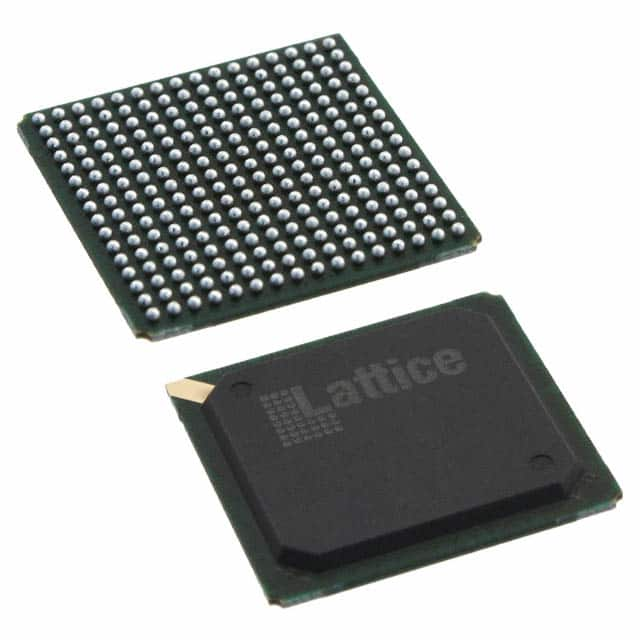Szczegóły produktu można znaleźć w specyfikacjach.

LFXP10C-4FN256C
Product Overview
Category
The LFXP10C-4FN256C belongs to the category of Field Programmable Gate Arrays (FPGAs).
Use
FPGAs are integrated circuits that can be programmed and reprogrammed to perform various digital functions. The LFXP10C-4FN256C is specifically designed for applications requiring high-performance and low-power consumption.
Characteristics
- High-performance FPGA with low power consumption
- Flexible and reprogrammable design
- Suitable for a wide range of applications
- Compact package size
Package
The LFXP10C-4FN256C comes in a 256-pin FineLine BGA (Ball Grid Array) package.
Essence
The essence of the LFXP10C-4FN256C lies in its ability to provide customizable digital logic functions, allowing designers to implement complex systems on a single chip.
Packaging/Quantity
The LFXP10C-4FN256C is typically packaged in reels or trays, with a quantity of 250 units per reel/tray.
Specifications
- Logic Cells: 10,000
- Flip-Flops: 5,120
- Look-Up Tables (LUTs): 5,120
- Block RAM: 360 Kbits
- Maximum Frequency: 400 MHz
- I/O Pins: 256
- Voltage Range: 1.2V - 3.3V
- Operating Temperature Range: -40°C to 100°C
Detailed Pin Configuration
The LFXP10C-4FN256C has a total of 256 I/O pins, each serving a specific purpose in the system design. For a detailed pin configuration diagram, please refer to the manufacturer's datasheet.
Functional Features
- High-speed performance
- Low power consumption
- Flexible and reprogrammable design
- Support for various I/O standards
- On-chip memory resources
- Built-in security features
Advantages and Disadvantages
Advantages
- High-performance FPGA suitable for demanding applications
- Low power consumption, making it energy-efficient
- Flexibility to implement complex digital systems
- Compact package size allows for space-saving designs
- Support for various I/O standards enhances compatibility
Disadvantages
- Limited logic cell count compared to larger FPGAs
- Higher cost per logic cell compared to larger FPGAs
- Limited availability of alternative models with similar specifications
Working Principles
The LFXP10C-4FN256C operates based on the principles of configurable logic. It consists of a matrix of programmable logic cells interconnected through configurable routing resources. The functionality of the FPGA is determined by the configuration data loaded into its internal memory.
Detailed Application Field Plans
The LFXP10C-4FN256C finds applications in various fields, including but not limited to: - Communications and networking equipment - Industrial automation and control systems - Medical devices - Aerospace and defense systems - Consumer electronics
Detailed and Complete Alternative Models
While the LFXP10C-4FN256C offers unique features, there are alternative models available in the market that cater to similar requirements. Some notable alternatives include: - Xilinx Spartan-6 XC6SLX9 FPGA - Intel Cyclone IV EP4CE6E22C8N FPGA - Microsemi ProASIC3 A3P060 FPGA
These alternative models provide different combinations of logic cells, I/O pins, and performance characteristics, allowing designers to choose the most suitable option for their specific application needs.
In conclusion, the LFXP10C-4FN256C is a high-performance FPGA with low power consumption, offering flexibility and reprogrammability. Its compact package size and support for various I/O standards make it suitable for a wide range of applications in different industries. While it has certain limitations, alternative models are available to address specific requirements.
Wymień 10 typowych pytań i odpowiedzi związanych z zastosowaniem LFXP10C-4FN256C w rozwiązaniach technicznych
Sure! Here are 10 common questions and answers related to the application of LFXP10C-4FN256C in technical solutions:
Q: What is the LFXP10C-4FN256C? A: The LFXP10C-4FN256C is a field-programmable gate array (FPGA) manufactured by Lattice Semiconductor.
Q: What are the key features of the LFXP10C-4FN256C? A: The key features include 10,080 Look-Up Tables (LUTs), 256 I/O pins, 4-input look-up tables, and 256 Kbits of embedded block RAM.
Q: What are some typical applications for the LFXP10C-4FN256C? A: The LFXP10C-4FN256C is commonly used in applications such as industrial automation, telecommunications, automotive systems, and medical devices.
Q: How can I program the LFXP10C-4FN256C? A: The LFXP10C-4FN256C can be programmed using various development tools provided by Lattice Semiconductor, such as the Lattice Diamond software or the iCEcube2 software.
Q: Can the LFXP10C-4FN256C be used in low-power applications? A: Yes, the LFXP10C-4FN256C has power-saving features like dynamic power management and sleep modes, making it suitable for low-power applications.
Q: What is the maximum operating frequency of the LFXP10C-4FN256C? A: The maximum operating frequency of the LFXP10C-4FN256C depends on the specific design and implementation, but it can typically reach frequencies of several hundred megahertz.
Q: Can the LFXP10C-4FN256C interface with other components or devices? A: Yes, the LFXP10C-4FN256C supports various communication protocols such as SPI, I2C, UART, and GPIO, allowing it to interface with other components or devices.
Q: Is the LFXP10C-4FN256C suitable for high-speed data processing? A: Yes, the LFXP10C-4FN256C is designed to handle high-speed data processing tasks, thanks to its high logic density and efficient routing architecture.
Q: Can the LFXP10C-4FN256C be used in safety-critical applications? A: Yes, the LFXP10C-4FN256C offers features like error detection and correction, making it suitable for safety-critical applications that require high reliability.
Q: Where can I find more information about the LFXP10C-4FN256C? A: You can find more detailed information about the LFXP10C-4FN256C, including datasheets, application notes, and reference designs, on the official website of Lattice Semiconductor.

